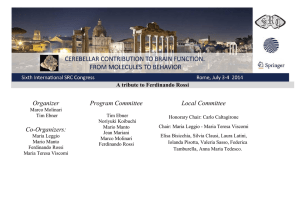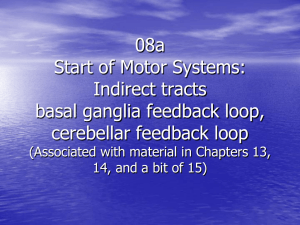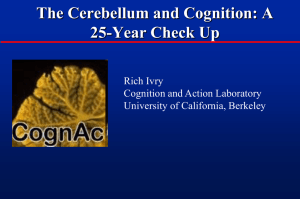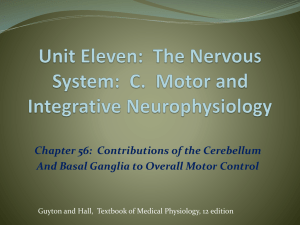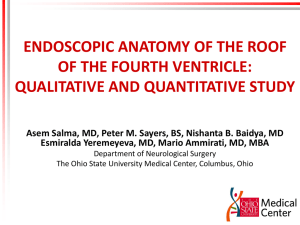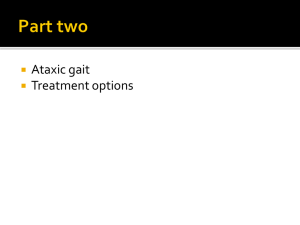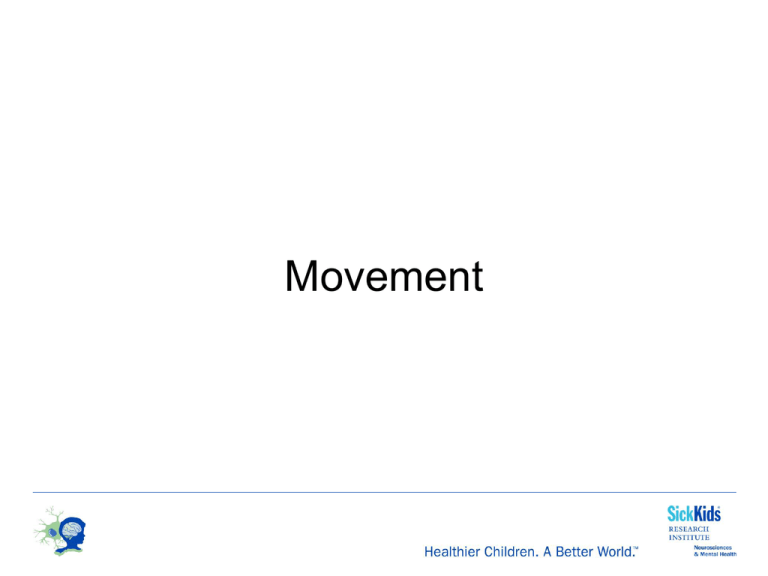
Movement
Motor Function: Cerebellar Signs
Dysmetria
•Dysdiadochokinesis (Jewell et al., 2010)
•Reaching (Norrlin et al., 2004)
•Motor reaction time (Dennis et al., 2009)
•Motor speed (Zeiner et al., 1985; Ziviani et al., 1990)
•Manual rotation time (Wiedenbauer & Jansen-Osmann, 2007)
•Speech fluency (Fletcher et al., 1995; Huber-Okrainec et al., 2002; Dennis et al.,
1987)
•Ataxia
•Truncal ataxia
•Limb ataxia (Hetherington & Dennis, 1999; Jewell et al., 2010; Lomax-Bream et al.,
2007)
•Motor rebound abnormality (Jewell et al., 2010)
Dysarthria
•Ataxic dysarthria (Huber-Okrainec et al., 2002)
Motor Function: Performance vs. Learning
Eye-hand control
Eye-hand control, dexterity, bimanual coordination (Fletcher et
al., 1995; Hetherington & Dennis, 1999; Lomax-Bream et al., 2007; Wills, 1993)
Drawing & handwriting
(Edelstein et al., 2004; Pearson et al., 1988;
Sandler et al., 1993; Soare & Raimondi, 1977; Ziviani et al., 1990)
Motor learning and adaptation
Adapting saccades to backward target displacement (Salman et al., 2006)
Adapting to prism-distorted visual input (Colvin et al., 2003)
Adapting drawing to mirror image (Edelstein et al., 2004)
Adapting ballistic arm movement to changes in relation between
movement and vision (Dennis et al., 2006)
Learning manual rotation task (Wiedenbauer & Jansen-Osmann, 2007)
Timing in Spina Bifida
Sensory motor (subsecond) timing
Brief auditory durations (~400ms) (Dennis et al., 2004)
Rhythm
Discrimination
Auditory rhythms (Dennis et al., 2009a; Hopyan-Misakyan
et al., 2009; Snow et al., 1994)
Production
Synchronizing tapping to external beat (Dennis et al.,
2004)
Entrained tapping to internally entrained beat (Dennis et
al., 2004)
Cognition
D
O
M
A
I
N
G
E
N
E
R
A
L
Entrainment
TIMING
Synchronicity
Exogenous
ATTENTION Endogenous
Predictive
MOVEMENT
Adaptive
Coordinate PERCEPTION Categorical
D
O
M
A
I
N
S
P
E
C
I
F
I
C
Constructed
LANGUAGE
Retrieved
Text
LITERACY
Word
Computation
NUMERACY Numeration
Dennis, Barnes: Developmental Disabilities Research Reviews, 2010)
Tectal Beaking And Midbrain
• The caudal expansion of the cerebellar vermis blocks the outlets of IV ventricle
and may even cause death.
• The rostral expansion of the cerebellar vermis comes at a cost to the midbrain,
producing a signature midbrain tectal beaking.
(L control; M normal tectum in SB; R beaked tectum in SB
Dennis et al., Neuropsychologia, 2005)
Inhibition Of Return
•Midbrain controls attention shifting,
including inhibition of return, by which
we do not orient repeatedly to the same
location.
•Biologically, increases chance of good
foraging and full environmental
exploration.
•We can study this in covert orienting
paradigm by manipulating latency
differences between validly and invalidly
cued targets.
Covert Orienting Paradigm
•Fixate centre cross and press button when target (star) appears.
•The cue (a bright flash of light before the target) is HELPFUL if it appears
right where the target will appear but MISLEADING if it appears opposite to
where the target will appear.
•Better detection of targets after HELPFUL cues represents the benefit
associated with having attention oriented to the cue.
•Slower detection of targets after MISLEADING cues represents the cost of
having had attention misdirected.
Inhibition Of Return
At the short (200 ms) latency, the minus values show the
DISENGAGEMENT COST associated with misdirecting attention on
invalidly cued trials. At the longer (1000 ms) time interval, the faster
response time to misleadingly cued targets results in positive numbers,
which shows INHIBITION OF RETURN.
Compared to controls or to children with SB and no tectal beaking,
children with SB and tectal beaking have less inhibition of return.
(Dennis, Edelstein, Copeland, Frederick, Francis, Hetherington, Blaser,
Kramer, Drake, Brandt, Fletcher: Neuropsychology, 2005)
Digression:
The Cerebellum And Affect In
History
Phrenology Master Plan (circa
1848)
Unusually, shows
specific brain gyri
locations for
traits.
1. Sex
4. Monogamy
Prepared for Fowler’s
lectures (Countway Library
Phrenology collection);
Reproduced in Macklis &
Macklis, Neurology, 1992.
Orson (1809-98) & Lorenzo (1811-96) Fowler
•Phrenology (English, Scottish version)
spread to America in the 1830s and
Fowlers were foremost American
phrenologists
•Phrenological cabinet, museum and
office just off Broadway in NYC
•How-to, self-help books
•Skull readings $1-3
•Public sex education
•Capitalized on expanding print industry
•Mail order business for phrenology and
physical hygiene, memory enhancement,
parenting, marital guides
•Pop versions of phrenology books
(including cranioscopic instruments)
Fowlers’ Phrenology: A
Practical Guide to Your Head
• Case
Studies With Illustrative
Busts and Sketches
• politician with well hung
cerebellum (Aaron Burr, upper left)
is lustful, war mongering, shoots
colleagues (see also Dick
Cheney)
• woman (generic, lower left) with
small cerebellum ? Asexual, ?
Peaceable, ? Shoots the breeze.
Affect
Affect In Spina Bifida: Clinical
• Children with SBM are warm and friendly, unlike autism spectrum
disorders.
• They actively seek out social contacts and work hard to maintain them.
• BUT
• Their language (“The Cocktail Party Syndrome”) is often full of
stereotyped social phrases that may serve the social function of
maintaining connectedness when their language output cannot keep
pace.
• The impression in the listener is that dialogue is off-target, and that
conversational partners are at cross-purposes.
• While children with SBM maintain social contacts, they have difficulty
terminating them, even when given socially relevant cues (“It’s been
good talking to you but you need to go now.”)
• Is being excessively friendly a form of social impairment?
• How can we explain the combination of warm and friendly, on the one
hand, and conversationally inappropriate, on the other?
Affect In Spina Bifida: Neurolinguistic
•Pragmatics is concerned with how speakers use language for
communication.
•Two classes of pragmatic principles:
•
•
Interpersonal rhetoric includes principles like cooperation, turn taking, politeness, and
irony, which are based on social conventions.
Textual rhetoric is oriented towards text production and interpretation, and involves
issues like:
•
•
•
•
processability (texts should be easy to process in real time)
clarity (the form of a text and its meaning should be transparent and unambiguous)
economy (a text should be syntactically economical) and
expressivity (a text should be well elaborated for meaning, including inferential meaning).
•Interpersonal rhetoric seems to be largely preserved in children with SBM, who
are polite and friendly, sociable, cooperative, and interested in talking.
•In conversations, they initiate as many or more turns and exchanges than
controls, and take turns in narratives (Murdoch et al., 1990).
•They have a normal vocabulary to express mental states (Dennis et al, 1994).
•In contrast, children with SBM have impaired textual rhetoric with respect to
ease of processing, clarity, economy, and expressivity.
Affect In Spina Bifida: Intact Or Impaired?
•The language of children with SBM is
disordered with respect to pragmatic
language processing
•BUT
•What does this mean for affective
communication?
•We have explored this question using facial
emotion as a tool to investigate two forms of
affective communication in children with
SBM.
Two Forms of Emotional Communication
• Facial expressions serve two types of communication (Buck, 1994).
• Emotional Communication
• Different facial expressions convey emotional states such as
happiness, sadness, anger, fear, and disgust through spontaneous
facial expressions that show what an individual feels.
• Emotive Communication
• Facial expressions also signal communicative intent, the conscious,
strategic modification of affective signals to show what an individual
chooses to display.
• Emotive communication of facial expression is governed by social
display rules that regulate which facial expression can be expressed,
who can express them, and when they may be expressed.
• Display rules involve cognitive control processes for conscious
modulation of felt emotion in response to social context.
Emotional vs. Emotive Paradigm
•Pretests
• Face emotion identification
• Verbal emotion identification
•“Molly woke up with a tummy ache. Molly’s mom
won’t let her go out to play if she know Molly has a
tummy ache, so Molly hides how she feels.”
•FEEL INSIDE QUESTION: How did Molly feel
inside?
•LOOK ON FACE QUESTION: How did Molly look
on her face?”
•CONCEALMENT QUESTION: WHY did Molly want
to hide how she felt?
Face Display
(Happy, Sad, Angry, Scared, Yucky)
Emotional vs.
Emotive
Communication
•Significant interaction (p<
.01) between group (SPINA
BIFIDA, CONTROL) and
QUESTION (LOOK ON
FACE, FEEL INSIDE).
•Children with SB appear to
have immature cognitive
control: few dissimulated, only
some neutralized, most
minimized or changed
inappropriately.
•Children with spina bifida
have difficulty with the
cognitive control of emotions,
even those they can identify.
(Koval V: Master of Arts thesis, University of Toronto, 2006)
Cerebellar Structure-Function
Correlations In Spina Bifida
Rhythm Synchronization vs. Rhythm
Entrainment in Spina Bifida
Synchronization
Rhythmic tapping in time to external beat
Entrainment
Rhythmic tapping to internally entrained
beat
(Dennis, Edelstein, Hetherington et al., Brain, 2004)
We Got Rhythm
•Rhythm emerges from temporal information creating
perception of strong (accented) or weak (unaccented) beats
at regular intervals.
•Strong-meter rhythms
•“On the beat.”
•Strong accents coincide with strong positions in metric
structure.
•Encoded as structured forms. Entrained as smooth motor
act.
•Weak-meter rhythms
•“Off the beat” or syncopated.
•Strong accents coincide with weak positions in metric
structure.
• Encoded as a series of independent units. Effortful
processing.
•The strong-meter advantage
•Strong-meter rhythms are easier than weak-meter rhythms
Rhythm In Spina Bifida. Results
•Accuracy (percent correct) and response times (in msecs) for
conditions were z-scaled based on the control group’s performance
(such that the mean performance in the control group received a score
of 0, and higher scores denoted lower response time or higher
accuracy). For strong and weak meter rhythms, the accuracy and
response time z-scores were averaged, resulting in a single score,
which was used as the dependent measure in analyses to follow.
• In the 3-group analysis, there was a significant group effect, and:
•For strong meter rhythms, SBM participants with thoracic lesions were
poorer than controls (p < .0001) or SBM with lumbar lesions (p=.0014).
•For weak meter rhythms, the two SBM groups did not differ from each
other, but each performed significantly below controls (upper p = .0084;
lower p=.0364).
•All children with spina bifida slower than controls even when accurate.
Rhythm In Spina Bifida
0.5
Accuracy
CONTROL (29)
SB LUMBAR (85)
0
STRONG METER
WEAK METER
-0.5
-1
-1.5
0.2
CONTROL (29)
SB LUMBAR (85)
0
Time
-0.2
-0.4
-0.6
-0.8
STRONG METER
WEAK METER
Metric Structure And The Cerebellum
•Strong-meter and weak-meter
rhythms produce different
cerebellar activation on fMRI.
•Strong-meter rhythm fMRI
activity in premotor area and
cerebellar anterior lobe (green).
•Weak-meter rhythm activity in
prefrontal cortex and cerebellar
posterior lobe (blue superior
posterior, khaki inferior
posterior).
Figure courtesy J.Juranek
Figure courtesy J.Juranek
Dysmorphisms And Rhythm
•Individuals with SBM are inaccurate and slow to discriminate rhythms.
•Those with LUMBAR (LOWER) spinal lesions did better on STRONG
METER rhythms and were able to capitalize on the predictability and
entrainment strong meters allow. This group has better motor function, less
brain dysmorphology in posterior fossa.
•Those with THORACIC (UPPER) spinal lesions [erfprmed poorly on
STRONG METER and WEAK METER rhythms and were unable to
capitalize on the predictability and entrainment strong meters allow.
Thisgroup has poorer motor function, more brain dysmorphology in
posterior fossa.
•Strong positive correlation of the corpus medullare with weak rhythms in
the THORACIC (UPPER) group (r=.71, p=.0209), but correlations are
exploratory.
•Compared to controls, spina bifida groups move
dysrhythmically, are slow to entrain rhythms, and perceive
rhythms poorly, so ?defective central rhythm generator related
to predictive timing function of cerebellum.
Clinical Implications
What Kind of Disorder Is SBM?
•SBM is a disorder of defective feedforward models that
create impairments in movement, space, time, and number,
as well as cognitive-academic functions they support
(reading, math).
•Associative, feedback operations are intact.
• Learning
• Semantic activation
• Categorical perception
•Assembled, feedforward operations are impaired.
• Inferencing
• Entrainment
• Coordinate perception.
What Can We Explain?
•Deficits in some functions are related to the cerebellum.
• Timing
• Movement regulation
• Ataxic dysarthria
• Rhythm
•Whether and how other functions are related to the
cerebellum is not clear.
• Cocktail Party Speech
• Emotive communication.
Associative vs. Assembled Processing
•Associative Processing is based on the formation of associations,
enhancement, engagement, and categorization. It includes adaptive
changes in response to stimulus repetition, as well as the activation
and categorization of stimulus information.
•In individuals with SBM, strengths in associative processing
facilitate temporal synchronicity, endogenous attention, adaptive
movement, categorical perception, retrieved language, word-level
literacy, and numeration and calculation procedures.
• Assembled Processingis based on on-line iterative cycles of
activation, disengagement, and integration; it includes the creation of
internal feed-forward models to guide performance over time.
•Weaknesses in assembled processing disrupt temporal
entrainment, exogenous attention, predictive movement, coordinate
perception, constructed language, text-level literacy, and most types
of mathematical problem solving.
Clinical Implications: No Diagnosis by Domain,
or Modality
•Individuals with SBM have functional assets in timing, attention,
movement, perception, language, literacy, and numeracy, as well
functional deficits in the same domains. It is misleading to classify
or diagnose by domain (“Perceptual Deficit, ” “Motor Deficit”)
because each domain has assets as well as deficits.
•Individuals with SBM have functional assets in audition and vision,
as well as functional deficits in the same sensory modalities, so
assets and deficits cannot be classified according to sensory
modality “(Visual Processing Deficit”); the fact that the auditory
modality has core deficits (in timing, above) and the visual modality
has both assets and deficits in perception means that the cognitive
phenotype of SBM cannot be explained by a simple dichotomy
between intact auditory and deficient visual perception.
Clinical Implications: No Simple Label
•No generic problem in “Perceptual Integration.”because
they perceive wholes and gestalts.
•No generic problem in “Temporal Sequencing Deficit”
because children with SBM have good ordinality (sense
of what comes first, second, etc) but poor temporal motor
regulation, which we believe is one cause of their
functional difficulty with movement control, drawing, and
handwriting.
Clinical Implications: Non-Verbal Learning Disability
•Individuals with SBM have functional assets and deficitsinvolving verbal
and non-verbal content, so no “Non-Verbal Learning Disability”.
•If we actually compare SBM and Non-Verbal Learning Disability on
some key domains, the profile of function is quite different.
•categorical perception specifies discrete spatial relations of visual primitives for
categories (objects), feature groupings (faces), or verbal locatives (e.g., above, below,
left, right)
•coordinate perception specifies precise spatial relations of visual primitives by
coordinate metrics (e.g., “the line and the dot are 2 cm apart”).
•In a virtual reality task, children with SBM can navigate by landmarks
(intact categorical perception) but not by spatial coordinates
(Wiedenbauer & Jansen-Osmann, 2006) (impaired coordinate
perception).
•Children assessed as having a Non-Verbal Learning Disability are
impaired in both categorical and coordinate perception (Mammarella et
al., 2009).
Clinical Implications: Remediation
•Better delineation of assets and deficits emerging from experimental
studies largely unexploited in motor, cognitive, and academic
remediation programs.
•That children with SBM have relatively good spatial orientation when
they use landmarks (compared to coordinates) provides an avenue for
improving extrapersonal orientation and ability to navigate in
environment and community.
•Clinical motor deficits are obvious in individuals with SBM, but extent of
the relatively well developed ability for motor adaptation and learning in
eye, arm, and hand in SBM has been underestimated and has not
formed an explicit component of programs to improve coordination and
handwriting.
•Cross-domain training is an underexplored area of rehabilitation in
individuals with SBM. In children with SBM, training in physical rotations
improves mental rotation skill.
Clinical Implications: Tailoring Treatments
•In children with SBM, there is some preliminary
evidence suggesting that:
• tailoring interventions to assets and deficits
may be effective (e.g., for math)
• basing treatments on an incorrect and
incomplete understanding of the core
deficit may be ineffective (e.g., for
attention).
Clinical Implications: Treating Math Deficits
•Executive function consists of representations, structured event complexes
(Grafman, 2002) that are the basis of skills like metacognition and planning, and
capacity-limited processing resources like working memory (Dennis, 2006).
•Children with SBM have executive dysfunction their executive representations
are more intact than their executive processing resources
•Children with SBM exhibit metacognitive control over their academic skills
(English et al., in press). Like typically developing children, they take more time
to read when the situation requires it (e.g., for study rather than for fun) and they
are accurate judges of their own understanding. They have poor working
memory.
•Representations like metacognition may be sufficiently functional to scaffold
forms of cognitive-academic rehabilitation.
•In a case series of adolescents with SBM, Coughlin and Montague (in press)
showed that a math word problem intervention that involved learning and
implementing executive strategies led to improved problem solving both postintervention and at long-term follow-up, as well as improving self-efficacy in
math.
Clinical Implications: Treating Attention Deficits
•Approximately one-quarter of children with SBM have reported difficulties in
attention although they are not hyperactive.
•Specifying the attention phenotype of SBM with experimental tasks has helped
to understand how it overlaps with, and diverges from, the cognitive-behavioral
phenotypes in other conditions.
•
For example, individuals with SBM have difficulties with midbrain attention orienting
tasks, such as inhibition of return, that are performed well by those with ADHD.
•A better understanding of the attention phenotype in SBM helps make sense of
some of the treatment outcome data.
•Children with SBM respond more poorly than children with ADHD to stimulant
medication treatment.
•SO
•Standard medication treatments for ADHD may be suboptimal for individuals
with SBM, whose attention profile does not include the response control deficits
that respond well to stimulant medication.
(Dennis, Sinopoli, Schachar, Fletcher, JINS, 2009)
End of Part 1
Acquired Posterior Fossa Tumors:
Cerebellar Medulloblastomas and
Astrocytomas
Childhood Cerebellar Tumors
Two most common childhood cerebellar tumors are
astrocytomas and medulloblastomas.
Cerebellar Astrocytomas are pathologically benign and are
treated with neurosurgical resection with no adjuvant
therapy.
Cerebellar Medulloblastomas are malignant tumors
requiring surgical resection and adjuvant therapy,
including chemotherapy and craniospinal radiation or high
dose chemotherapy with autologous stem cell
rescue/bone marrow transplant in children younger than
three years old.
Childhood Cerebellar Tumors: Treatment
•In survivors of childhood brain
tumors, craniospinal radiation is
consistently associated with
significantly lower cognitive and
neurobehavioral functioning.
•Chemotherapy, especially agents
like methotrexate, have additive
effect on toxicity and morbidity.
•Treatment effects interact with
age, gender, and time since
treatment.
(Dennis, Spiegler, Riva, MacGregor: In: Brain And Spinal Tumors Of Childhood, 2004 )
Childhood Cerebellar Tumors
MEDULLOBLASTOMA
ASTROCYTOMA
(Pre-surgical MRI axial images)
Note. As is typical, both tumors have a midline cerebellar vermis location.
Movement
Cerebellar Signs: Acquired cerebellar lesions
•Children with cerebellar tumors exhibit:
•Dysmetria
•Ataxia
•Dysarthria
•These deficits persist before and after
treatment.
Ataxic Dysarthria
•Motor speech deficits associated with cerebellar lesions,
termed ataxic dysarthria, are characterized by:
•
•
•
•
motor slowing
imprecise articulation
altered prosody of speech
monotonous vocal pitch, monoloudness, and harsh voice
quality.
• Cerebellar lesions also influence the fluency of speech
production, resulting in repetition of syllables and individual
phonemes as well as prolonged intervals between words
and syllables.
Ataxic Dysarthria in Cerebellar
Tumors
• Video-taped speech samples from cerebellar tumor survivors (mean
age 13) and controls were analyzed by two speech pathologists for
ataxic dysarthria, dysfluency, and speech rate.
• Medulloblastoma (n=25; 6 children and 19 adults)
• Astrocytomas (N=29, 15 children and 14 adults)
• Controls (n=40; 20 children and 20 adults).
• Medulloblastoma survivors had more ataxic dysarthria than either
astrocytoma survivors or controls, who did not differ.
• Both tumor groups were more dysfluent than controls, and did not
differ.
• Neither tumor group improved speech rate from childhood to
adulthood.
• Dysfluent and slow speech occur in cerebellar tumor survivors,
regardless of tumor type and whether radiated or not.
(Huber-Okrainec, Dennis, Bradley, Spiegler : Neuro-Oncology, 2001)
• Childhood cerebellar tumors slow speech rate development.
Mutism With Subsequent Dysarthria (MSD)
• A severe motor speech complication following childhood
cerebellar tumor resection is a transient period of complete
loss of motor speech production, commonly referred to as
“transient cerebellar mutism.”
• Because mutism progresses into dysarthria, the condition
often called “mutism with subsequent dysarthria” (MSD).
• MSD occurs in approximately 7.5% of patients and is more
prevalent in childhood than adulthood.
• Following surgical resection, a postoperative period of
normal well-preserved speech production lasts from 24 hr
to 6 days before mutism ensues and lasts for days to up to
4 months.
MSD: Two Unresolved Issues
• Do children with postoperative transient cerebellar mutism after
cerebellar tumor resection show very long-term motor speech
disorders?
• Are long-term motor speech disorders in these children greater than
those in children with cerebellar tumors without transient cerebellar
mutism?
• Using a triplet match methodology, studied motor speech in three
groups:
• Childhood cerebellar tumors who had developed postoperative TCM
• Childhood cerebellar tumors who had not developed postoperative TCM
• Typically developing age peers.
• Hypothesized
• long-term survivors of childhood cerebellar tumors followed by transient
cerebellar mutism would show chronic motor speech deficits that persisted
as a(Huber,
milder Bradley,
form of ataxic
dysarthria.
Spiegler,
Dennis: Child’s Nervous System, 2006)
• survivors with a history of transient cerebellar mutism would have more
severe motor speech deficits than those who had not developed the
MSD: Long-Lasting If Not Permanent
• Compared to either controls or cerebellar tumor survivors
with no transient cerebellar mutism, those survivors with a
history of transient cerebellar mutism had:
• significantly more ataxic dysarthric speech
• slower speech
• more speech dysfluencies.
• Motor speech disorders in the form of ataxic dysarthria are
a chronic if not permanent sequel of transient cerebellar
mutism.
(Huber, Bradley, Spiegler, Dennis: Child’s Nervous System, 2006)
Adult Survivors of Childhood Cerebellar
Tumours Have Subsecond Timing
Deficits
•Participants
•20 medulloblastomas
•20 astrocytomas
•20 controls
•Subsecond (sensory-motor) timing deficits
•Impaired thresholds for perception of duration
(around 400 ms)
•Normal thresholds for perception of frequency
(around 3000Hz)
•Preserved ability to estimate longer durations (30 min)
(Hetherington, Dennis, Spiegler: J Int Neuropsychol Soc, 2000)
Speeded Motor Control Does Not
Improve Up To 40 Yr After Diagnosis
•Long term survivors of
childhood medulloblastoma
(N=17).
•Solid (colored) lines represent
individual cases.
•Dotted black line is the trend
line from the growth curve
model.
•No change over time in
survivors many years since
diagnosis.
•[Little data from the initial 5
(Edelstein, Spiegler, et al: manuscript
in preparation;
INS presentationcan’t
2009)
years
after diagnosis,
model the initial decline).
Age at diagnosis: < 4; 4-7.5; > 7.5
Cognition
Cognitive Functions & Cerebellar
Tumors
•Many cognitive functions are impaired in child and adult
survivors of childhood cerebellar tumors
•Intelligence
•Language
•Visual perception
•Executive planning, metacognition, prospective time estimation)
•Executive resources (working memory, inhibitory control)
•Problems Interpreting Deficits
•Specificity vis-à-vis cerebellum?
•Primary vs. secondary deficit?
•Cerebellar function vs. cerebro-cerebellar circuit?
Study Of DTI Tractography And
Working Memory
• Can a cerebellum-DLPFC pathway be identified in
children with posterior fossa tumors and controls?
• Is integrity of this pathway compromised in patients
relative to controls as measured by DTI indices (FA,
MD, and radial and axial diffusivity).
• Are deficits in working memory present and, if so, are
deficits related to integrity of cerebellum-corsolateral
prefrontal cortex (DLPFC) ?
• medulloblastoma, astrocytoma, control (mean age
10.5yr).
(Mabbott, Rockel, Scantlebury, Law, & Bouffet. Probabilistic tractography
of cerebellar-cerebral connections in paediatric brain tumor
patients: Proc. Ann Mtg Int Soc. Mag. Res. Med, 3408, 2009).
Cerebello-thalamo-cortical Pathway
Tracts were produced that clearly replicated the cerebello-thalamo-cortical pathway
that has been delineated in prior animal models (Schmahmann, 1996) for both
patients (LEFT) and control (RIGHT). Tracts cross over to contralateral side from
cerebellar seed in red nucleus, from where they extend into the thalamus and then
into the dorsolateral
prefrontal
cortex.
(Mabbott, Rockel,
Scantlebury,
Law, & Bouffet. Probabilistic
tractography of cerebellar-cerebral connections in paediatric brain tumor
patients: Proc. Ann Mtg Int. Soc. Mag Res. Med, 3408, 2009).
Regional Pathway Integrity
A statistically significant main effect for region (i.e.
cerebellum, pons, mid regions, frontal) was evident across
all DTI indices.
-For FA and radial diffusivity, main effects were qualified
by a region by group interaction.
For medulloblastoma relative to astrocytoma or controls ((p <
0.01), and for cerebellar regions across tracts:
*
• Radial diffusivity (mm2/sec) significantly higher,
indicating reduced myelin integrity of axons
• FA was significantly lower, indicating possible
breakdown of myelin and axonal fibre degeneration.
(Mabbott, Rockel, Scantlebury, Law, & Bouffet. Probabilistic
tractography of cerebellar-cerebral connections in paediatric brain tumor
patients: Proc. Ann Mtg Int. Soc. Mag Res. Med, 3408, 2009).
Group Differences In Working
Memory
• Significant group effect [F(2, 59) = 4.012, p = 0.02]
• Tumor groups performed more poorly than controls (p = 0.02).
• Astrocytomas had better working memory than medulloblastomas (p
= 0.04).
*
(Law: Masters of Arts thesis, University of Toronto, 2009)
White Matter Integrity Of Cerebellum-DLPFC
Pathway And Working Memory
•For tract connecting the right cerebellar hemisphere
to the left DLPFC via the left thalamus, FA and radial
diffusivity were correlated with WMI (r = 0.334, p =
0.008 and r = -0.312, p = 0.014, respectively).
•For the tract linking left cerebellar hemisphere to the
right DLPFC via the right thalamus, only FA was
correlated with WMI (P = 0.262, p = 0.04).
(Law: Masters of Arts thesis, University of Toronto, 2009)
Symptom Variability And
Functional Outcome After
Childhood Cerebellar Tumors
Outcome Variability: Cerebellar Tumors
•Children treated for cerebellar tumors experience pre-, peri-,
and postoperative medical events.
•Conflicting evidence about relation between medical events
and long-term neurobehavioral outcome, so we developed an
index of medical events based on retrospective coding,
clustering, and weighting of information obtained from
records.
• The first aim was to document the incidence and natural history
of adverse medical events throughout the course of PF tumor
diagnosis, treatment, recovery, and long-term survival.
• The second aim was to examine whether medical events
occurring perioperatively and in the short- and long-term
survival
periods
predicted
long-term
neurobehavioral
outcome.
(Roncadin,
Dennis,
Greenberg,
& Spiegler:
Child’s Nervous System,
2008)
Pre- Peri- Postoperative Medical Events
Time periods:
• diagnosis (at presentation)
• perioperative (initial in-patient hospital stay)
• short-term survival (during first 5 years post-initial
hospitalization)
• long-term survival (beyond 5 years post-initial
hospitalization).
Roncadin, Dennis, Greenberg, & Spiegler: Child’s Nervous System, 2008)
Symptom Profile & Cognitive
Outcome
(Roncadin, Dennis, Greenberg, & Spiegler: Child’s Nervous System, 2008)
Are Symptoms Related To Outcome?
Long-term outcome is related to the occurrence of timedependent medical events in astrocytoma survivors.
Neuroanatomical variables have been associated with functional
outcome in astrocytoma survivors.
Greater perioperative and short-term medical adversity contributes to
lower IQ in the long term.
Poorer memory, within the impaired range for individual AST
survivors, is associated with a younger age at diagnosis, more
perioper- ative events, and more events in the first 5 years
postsurgery.
Lower functional independence is associated with more perioperative
and short-term survival events.
Radiated medulloblastoma survivors experience marked
changes in the trajectory of neuropsychological development.
Roncadin, Dennis, Greenberg, & Spiegler, Child’s Nervous System, 2008)
Affect
Cerebellar Cognitive-Affective Syndrome
•Reported in adults and children post cerebellar
lesions.
•Consensus that the CCAS exists, but less
agreement about its definition and measurement.
•Term implies failure of emotion identification and/or
disturbed emotion-cognition interface, but one or
both?
•Some CCAS reports describe deficits in the
awareness of emotions, others identify deficits in
cognitive control.
•Cognitive control of emotion involves the ability to
CCAS In Music
•Emotion identification and the cognitive control of emotion..
•37 children (7-16 years) treated for cerebellar tumors
•19 benign astrocytomas (AST)
•18 malignant medulloblastomas (MB)
•37 matched typically-developing controls (CON).
•Emotion Identification Task: how well do children recognize
emotions and which features of music do they use to do so?
•Affective Music Stroop Task: can children focus on emotion
in music when emotion in the lyric and music is either
congruent or incongruent.
(Hopyan, Laughlin, Dennis: Emotions and Their Cognitive Control in
Children with Cerebellar Tumors, submitted).
How Music Encodes Emotion
•Music encodes emotion by
• mode (the specific subset of pitches used to write a given
musical excerpt, e.g., major and minor modes) and
• tempo (the number of beats per minute).
•Mode and tempo may be independently varied to
elicit different emotions.
• Fast tempi evoke a happy tone, slow tempi a sad tone.
• Music played in a major mode is perceived as happy
and music played in a minor mode is perceived as sad.
• Children as young as 6 to 8 years of age are as
accurate as adults at identifying emotions in music; like
adults, they vary their judgments of emotion in music
with changes in both tempo and mode, and they can
identify unfamiliar music as being happy or sad.
Emotion Identification Task
•96 brief piano excerpts reliably
rated as either happy or sad by
adults and children 6-8 years of
age.
Music Emotion Rating Scale
•In Original condition, excerpts were
in canonical form.
•In Mode Change condition,
excerpts were mode transcribed
from major to minor, or from minor
to major.
•In the Tempo Change condition,
tempi were set to median of original
tempi.
•In the Mode+Tempo change,
excerpts were transcribed to
opposite mode of the original song
(Hopyan,
Dennis:
Emotions
and all
tempi Laughlin,
set to the
median
of and Their Cognitive Control in
Children with Cerebellar Tumors, submitted).
the original tempi (this manipulation
essentially neutralizes the emotion).
Emotion Identification: Results
Medulloblastoma And Sad Emotions
Cognitive Control Of Emotion
“Music Stroop” Task
•48 original musical excerpts from Emotion
Identification task.
•a cappella female voice sang the lyric happy or
sad, which either matched or mismatched the
emotion in the music.
•In Congruent condition, lyrics matched music
(happy music sung with lyric happy, sad music with
lyric sad).
•In Incongruent condition, lyrics mismatched music
(happy music sung with lyric sad, sad music with
lyric happy).
•Task: Attend to and rate emotion in the
music.
Cognitive Control of Music Emotion:
Results
(Hopyan, Laughlin, Dennis: Emotions and Their Cognitive Control in
Children with Cerebellar Tumors, submitted).
Affect And Cerebellar Tumor
Location
Pre-operative MRI
tumor location
MEDULLO
BLASTOMA
(N=17)
Anterior lobe
8 (47%)
ASTRO
CYTOMA
(N=19)
6 (32%)
Posterior-superior lobe 4 (24%)
14 (74%)
Inferior-posterior lobe
12 (71%)
16 (84%)
Corpus medullare
4 (24%)
11(58%)
Hemisphere Right
5 (29%)
10 (53%)
Hemisphere Left
2 (12%)
8 (42%)
Vermis
15 (88%)
15 (79%)
• Vermis tumor
involvement both
groups.
• Hemispheric tumor
involvement more
frequent in AST group
(X2 = 4.48, p = 0.02),
especially in left
cerebellar hemisphere
(X2 = 3.60, p = 0.05).
• More tumor
involvement in superior posterior lobe in AST
group (X2 = 5.56, p =
0.01).
• Cerebellar tumor
location more similar in
MB and AST groups
than suggested in the
literature.
Cerebellar Tumor Location & Emotion
•Emotion Identification not significantly related to
tumor location in either group.
•In AST group, Cognitive Control (Musical
Stroop) positively related to right hemisphere
tumor location , r = .53, p = 02.
•In MB group, Cognitive Control positively
related to anterior lobe tumor location, r = .52, p
= .03.
•Results are exploratory, but support idea of
cerebellar role in Cognitive Control of Emotion
rather than in Emotion Identification.
Clinical Implications: Not psychometrics
•Impairments in emotion and the cognitive control of
emotion are dissociable from psychometric test
performances.
•Despite differences in performance across psychometric
tests between the tumor groups and controls, children in
the astrocytoma group performed as accurately and as
quickly as controls on the emotion identification task,
children in the medulloblastoma group generally
performed similarly to controls, and both tumor groups
were impaired on the cognitive control task.
Clinical Implications: Cerebellar Cognitive
Affective Syndrome
•Children with cerebellar tumors were able to identify
emotions, and they used the same features (mode,
tempo) as typically developing children to do so.
•Nevertheless, they had difficulty with the cognitive
control of emotion.
•The suggests that the Cerebellar Cognitive Affective
Syndrome in children is a disorder of the regulation of
emotion, rather than of emotion identification.
Clinical Implications: Speech Prosody
•Recent hypotheses have proposed that the right
cerebellum differentially processes high pass filtered
information (segmental properties) and the left
cerebellum differentially processes low pass filtered
information, including the prosodic information important
for speech prosody, affect, and singing (Callan et al.,
2007).
•The fact that astrocytoma tumor involvement in the right
cerebellar hemisphere preserved cognitive control of
emotion may mean that the left cerebellar hemisphere is
more important than the right for cognitive control in
music, which is the key component of language prosody.
Clinical Implications: Astrocytomas
•Clinical reports focus on the major neurocognitive
deficits of children with radiated cerebellar tumors, with
less attention being paid to the astrocytoma group in
terms of planned follow-up and monitoring.
•Nevertheless, recent data suggest non-trivial cognitive
morbidity in astrocytoma survivors, especially in the longterm, and our data show that the cognitive control of
emotions is significantly impaired in this group.
•Children treated for astrocytoma need planned followup, because they at some individual risk for cognitive
deficits and at group risk for cognitive-affective deficits.
Where Are We With Studies Of
Cerebellar Structure and
Function In Neurodevelopmental
And Childhood Acquired
Cerebellar Disorders?
There is GOOD NEWS and BAD
NEWS….
The Good News: # 1
•There is a burgeoning data base on the
effects of both developmental perturbations
of the cerebellum and childhood acquired
cerebellar disorders.
•Because so many childhood disorders
involve some form of cerebellar structural
or functional anomaly, this is a GOOD
THING.
The Good News: # 2
•We are beginning to move away from purely
descriptive analyses of the cerebellum
towards a more quantitative approach:
• Cerebellar volumetrics
• Cerebellar parcellations
• Just beginning cerebellar tractography.
•This will grow to form the basis of a corpus of
knowledge about developmental perturbations
of the cerebellum and childhood acquired
cerebellar disorders, so this is a GOOD
THING.
The Good News: # 3
•In an earlier era, the only thorough analyses
of cerebellar disorders involved descriptions
of post-mortem material.
•For example, we know a vast amount about
the post-mortem features of the cerebellum in
Dandy-Walker syndrome and variants but
relatively little about living children with this
condition.
•Now, children living with cerebellar disorders
can be imaged in vivo and their imaging
correlated with measures of motor, cognitive,
and affective function, which is also a GOOD
THING.
The Good News: # 4
•Because there is now a consensus that
the cerebellum is important for more
than movement, clinical researchers are
increasingly willing to look at functions
that are actually interesting:
• From a neurocognitive perspective
• From an ecological, real-world
perspective.
•This is also a GOOD THING.
The Bad News: # 1
Many cerebellar disorders are still
understudied, which is a BAD THING.
•
Developmental cerebellar
dysmorphology
• Spina bifida meningomyelocele
• 22q11.1 Deletion Syndrome
• Autism
• Asperger syndrome
• Williams syndrome
• Down Syndrome
• Fragile X
• Dandy-Walker syndrome & variants
• Joubert syndrome
•
Acquired cerebellar lesions
• Cerebellar
medulloblastoma
• Cerebellar astrocytoma
• Cerebellar strokes
• Traumatic brain injury
• Prematurity
• Alcohol & drug use
The Bad News: # 2
•Most information comes from psychometric, omnibus
outcome measures, which are not designed to target
the unique issues of the cerebellum.
•Many relevant constructs targeting what is uniquely
wrong about the cerebellum are insufficiently or
incorrectly parsed by standard psychometric tests
•For example, there are really no psychometric
measures useful in identifying and diagnosing the
Cerebellar Cognitive Affective Syndrome.
•We don’t yet have a workable coalition of
psychometric and cognitive measures, which is a BAD
THING.
The Bad News: # 3
•Some of the clinical research effort in ceebellar
tumors seems incorrectly focused, which is a
BAD THING.
•For example, several articles reject the idea that
medulloblastomas are of theoretical interest
because of radiation effects, without recognizing
that there is a natural comparison group in
benign cerebellar tumors rather than in a random
collection of “extra-cerebellar” tumors.
The Bad News: # 4
•A number of research studies of cognitive
function in childhood cerebellar disorders
attempt to ‘parcel out’ or ‘control for’ motor
impairments.
•Of course, studies should have control of the
motor demands of the task
BUT
•We are movement (some of us even believe
that there is no cognition that it not motor) so
dysmetria and dysrhythmia cannot be
‘extracted’ from cognition.
•Thinking that motor and cognitive issues are
subtractive is a BAD THING.
The Bad News: # 5
•In some neurodevelopmental disorders, cerebellar
involvement becomes the brain insult du jour, causally
invoked to explain broadly defined functions.
•ADHD as timing disorder caused by cerebellar disorder BUT
•Time perception may involve different timescales.
• Subsecond interval timing requires the cerebellum
• Suprasecond timing involves a more distributed network including basal
ganglia.
•ADHD deficit in executive control (suprasecond estimation)
rather than subsecond timing that is the output of the olivocerebellar system, which generates temporal patterns in the
inferior olive to time intervals (~hundreds of ms) using
oscillations to keep track of time (Jacobson et al., 2008).
•Appealing randomly to cerebellar disorder as an explanation
of dysfunction without being able to tie the function to the
cerebellum theoretically and empirically is a BAD THING.
Does the Cerebellum Exhibit
Age-Based Plasticity,
Structural And/Or Functional?
What Does Age-Based Plasticity Mean?
•Plasticity is not an aberrant state; it is what the
brain is designed to do, and what it does
normally.
•A pop version of plasticity has it that a
“Kennard Principle” based on work in the
1930s-1940s showed that early brain insult has
fewer, and more transient effects than damage
to the mature brain.
•Before considering the issue of plasticity in
relation to children with neurodevelopmental
disorders and childhood acquired lesions of the
cerebellum we will digress to discuss the
“Kennard Principle,” which is
•neither Kennard’s
•nor a principle.
Digression:
The “Kennard Principle”
Margaret Kennard (1899–1975)
•The supposed ‘Kennard Principle’ asserts a
negative linear relation between age at brain
injury and functional outcome: Other things
being equal, the younger the lesioned
organism, the better the outcome.
•But other things are never equal, and the
‘Kennard Principle’ is neither Kennard’s nor a
principle.
•Kennard sought to explain factors that
predicted outcome (age, to be sure, but also
staging, laterality, location, and number of brain
lesions, outcome domain) and the neural
mechanisms that altered the lesioned brain’s
Dennis M. Margaret Kennard (1899–1975): Not a ‘Principle’ of brain plasticity
functionality.
but a founding mother of developmental neuropsychology, Cortex (2009),
doi:10.1016/j.cortex.2009.10.008
Age Not Sole Predictor Of Early
Lesion Outcomes
•Kennard’s overarching interest was how
functionality was effected in the lesioned brain.
•Even had she sought to identify a single principle
for recovery of function – and I believe she did not
– age at lesion would not have been that principle.
•For Kennard, early brain damage did not
consistently spare function or optimize functional
outcome, but could be more, less, or equally
disabling than later-onset injury depending on the
features of the injury, post-injury neuroanatomical
reorganization, the staging of the lesion, how and
when outcome was assessed.
Plasticity of Motor Function: Neurodevelopmental
•Despite congenital onset, children with spina bifida have:
• Dysmetria
• Ataxia
• Dysarthria
• We believe that their motor deficits involve defective
feed-forward, predictive motor control coupled with
intact feedback-adaptation learning.
• Current models of adult cerebellar motor function
stress disorders of predictive control, which is what
we see in spina bifida, so there is little plasticity for
core cerebellar motor functions.
Plasticity of Motor Function: Acquired Lesions
•Children with acquired cerebellar lesions continue to have
motor deficits long after their tumor treatment, including:
• Dysmetria
• Ataxia
• Dysarthria
• Malignant tumors and their treatment result in poorer
long-term adaptive and motor function than do nonmalignant tumors treated by surgery alone.
• There have been no clinical research studies that
study the kind of theoretical issues in motor control
that have been addressed in adult lesions so we
currently cannot characterize the nature of the motor
impairment in childhood cerebellar acquired lesions.
The Special Case Of Eye
Movements
•Cerebellum has important role in
control of eye movements.
•visual fixation
•vestibulo-ocular reflex
•binocular alignment
•saccade accuracy and adaptation
•smooth pursuit.
Plasticity of Eye Movements?
•
Eye movements correlated with
midsagittal vermis expansion
(lobules VI-VII).
•
Midsagittal vermis expanded in
children with spina bifida with
normal eye movements.
•
Dysmorphic vermis expansion
preserves ocular functions of
vermis (saccadic accuracy,
adaptation, smooth pursuit).
Eye movements are better with
expanded cerebellar tissue, but is
this functional plasticity?
•
(Salman, Dennis, & Sharpe: Canad J Neurol. Sci., 2009
Plasticity of Affective Function
•The Cerebellar Cognitive Affective Syndrome occurs in
both children and adults with cerebellar disorders.
•In spina bifida, this co-occurs with excessive sociability.
•In cerebellar tumors, it co-occurs with more autistic
spectrum symptoms.
•[In cerebellar tumors, it is unrelated to the presence of
the Posterior Fossa Syndrome, i.e., to mutism with
subsequent dysarthria]
•Despite the fact that spina bifida is a
neurodevelopmental disorder and cerebellar tumors are
acquired conditions, both groups have difficulty in the
cognitive control of affect.
•Little age-based plasticity for cerebellar affective
dysregulation, but some important differences between
neurodevelopmental and acquired childhood conditions.
Knitting It All Together
These days, even knitted brains include the cerebellum…..
Knitted by Dr Karen Norberg, Cambridge, Massachusetts.
http://www.telegraph.co.uk/news/newstopics/howaboutthat/4245919/Psychiatrist
-knits-anatomically-correct-woolly-brain.html
Grant Support
• US National Institutes of Health Program
Project Grants (1998-2010) P01 HD35946 P01
HD35946-06
• National Cancer Institute of Canada
Colleagues (Houston & Toronto)
•Marcia Barnes
•Susan Blaser
•Michael Brandt
•Paul Cirino
•Sabine
Doebel
•James Drake
•Kim Edelstein
•Jack Fletcher
•David Francis
•Khader Hasan
•Talar Hopyan
•Joelene Huber
•Derryn Jewell
•Jenifer
Juranek
•Elka Miller
•Rebekah
Nelson
•Andrew
Papanicolaou
•Charles
Raybaud
•Michael
Salman
•Brenda
Spiegler
•Amy Walker
•Elyse Widjaja

